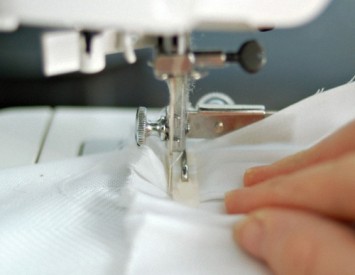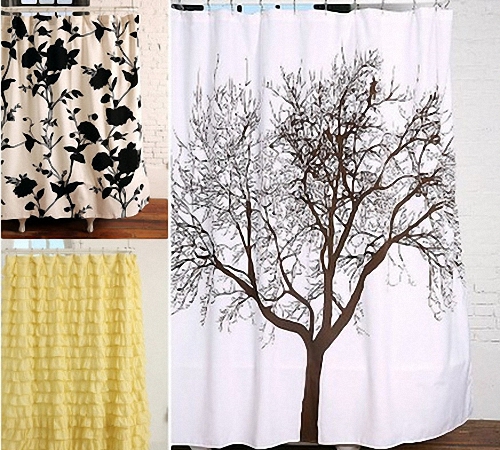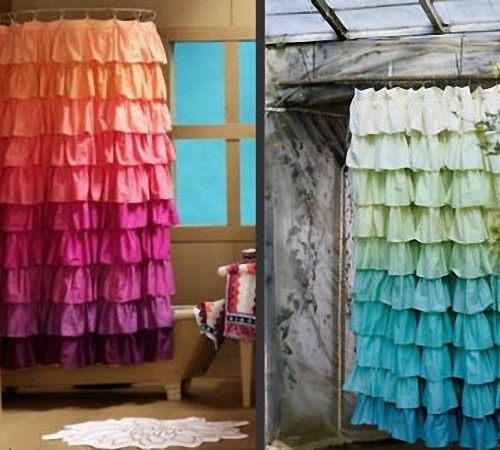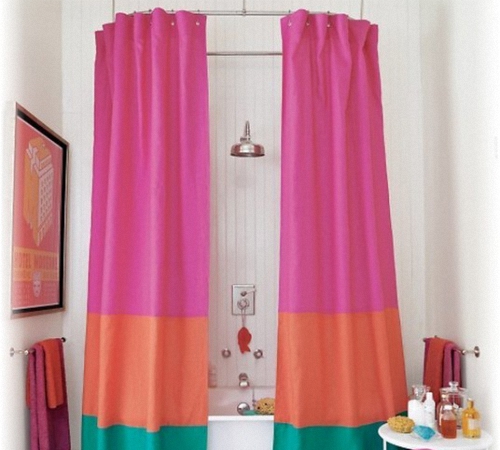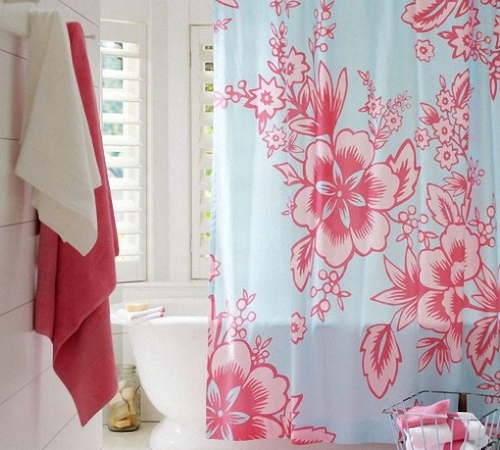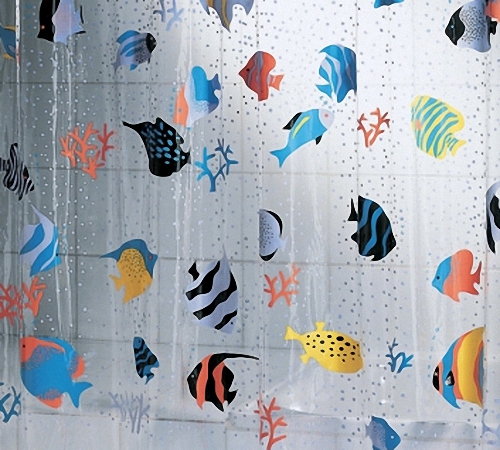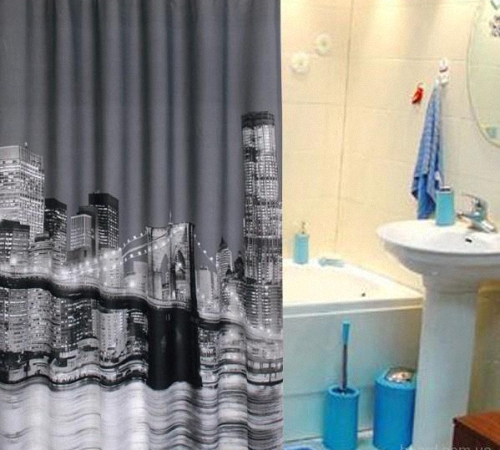The curtains and curtains for the bathroom are important - an element for those who love to retire and be alone with them, like glass, they protect against spraying water and foam, but unlike it, are not transparent. In addition, the curtains are much easier to care for. There are no salt deposits on them, they cannot be broken or accidentally damaged. All these factors affect the fact that the curtain for the bathroom is still relevant and popular.
Content
Types of curtains
Depending on the material, the curtains are divided into:
- fabric,
- plastic.
Fabric curtains allow fantasies to walk in full. Firstly, this is due to the abundance of various materials, and secondly, it is quite simple to make curtains for the bathroom, which allows not only to save, but also to get the most optimal solution, which is fully consistent with your taste preferences.
Fabric curtains are divided into:
- simple,
- combined,
- complex,
- with decorative elements.
Simple curtains are products for which only one type of fabric is used. Combined consist of several different fabrics. Complex curtains include various forks, plissing, etc. In their design. Curtains with decorative elements can be made according to any of the above technologies, but they are distinguished by the presence of certain decorative elements (embroidery, drawing, etc.).
Plastic curtains are much simpler fabric. This is a regular section of the material that is decorated with stickers or drawings. It is advisable to use it only when you want to do the work as quickly as possible and not bother with sewing too much. Modern flexible plastic is of a wide variety of shades and degrees of transparency, so it is suitable for any interior.
Preparatory work
Before proceeding with the manufacture of curtains, it is necessary to perform several preliminary actions:
- think through the design
- choose material,
- equip fasteners,
- check for serviceability sewing equipment.
The external design of the curtains is quite important, as this is one of those deco items, which immediately catches the eye. There can be two options:
- key,
- contrast.
Tonality suggests that the curtain will be combined with the general color scheme. Moreover, it does not have to fully match the color. Only individual drawings can stand out, but they should fall into the tone of the other interior items. This option is most often found, as it is win -win.
The game of contrasts is that the color of the curtain is selected directly opposite to the tile. It is important that in addition to the curtains there are other brightly distinguished objects. It can be furniture or individual elements, for example, tiles in the form of a picture. A contrasting option is more likely to be an amateur, since its goal is to shock it and with everyday use this design will most likely begin to irritate.
If you stopped on plastic, then everything is simple, but you must carefully approach the choice of fabric. The first thing you should pay attention to is moisture. It will be quite a lot, so thick fabrics are not allowed. They will be constantly wet and very heavy, which will quickly bring the attachment into the unusable. Thin natural fabrics are also not suitable for the curtain, they will become a moisture collector from which puddles will constantly relate.
Based on this, attention should be stopped exclusively on synthetic tissues. No restrictions are acting here and everything depends solely on imagination.
It is not easy to sew curtains for the bathroom, they still need to be fixed. The mounts are installed in advance. The mechanism consists of:
- guide bar (usually a round galvanized pipe),
- two fixers,
- set of screws with dowels.
At the required height, holes under the dowel are drilled in the wall and fixers are attached. Then, the guide bar is inserted into them and is fixed using crimp bolts.
In practice, it often happens that our ideas differ from how a thing looks in life. Therefore, it is better to check and play the height of the curtain in advance, so that later you do not have to redo it.
Quite often, especially in showers, you need a corner curtain for the bathroom. It, in fact, is no different from the usual one. The only thing you should choose not a straight line, but a semicircular guide bar.
The preparatory work is completed by checking the sewing machine. It is better to do this before the purchase of the material, so if a sufficiently serious breakdown is found, it will be possible to take another material or change the design, instead of buying a new sewing unit or giving it up for repairs.
How to make curtains for a bathroom made of plastic?
Ready -made plastic curtains are represented in a richest assortment and, nevertheless, do not arrange everyone. The choice of material is due to its practicality, but the external design, as a rule, leaves much to be desired. Consider a few interesting solutions. A choice of curtains for the bathroom will help to make a choice.
Option 1 - Decorate the finished curtain.
Plastic interacts perfectly with any varieties of molecular glue, therefore, the store is bought in the store the simplest curtain, which is brought to mind already at home.
There are a lot of decoration methods:
- application,
- decoupage,
- mosaic,
- fresco.
Application involves gluing various plastic elements. It can be:
- flowers,
- animals,
- abstract pictures.
Although this is the simplest solution, it looks quite original.
The decoupage decoupage technology is one of the most complex, but the most spectacular. To do this, you will need high -quality white acrylic. The work is performed as follows:
- roll out the curtain on a flat surface (pre -put newspapers or film so as not to dirty anything),
- paint it with paint and wait until it dries completely,
- while the paint dries, prepare decoupage cards,
- process the painted surface with well -diluted PVA glue with water (there should be liquid as water),
- apply decoupage cards and wait until the picture is absorbed and dry,
- art Deco at will,
- open with moisture -resistant varnish (at least three times).
Mosaics are assembled from pieces of colored glass, which are fixed with glue. Outwardly, it looks very original, but the work is quite painstaking, in addition, you will have to try 3-4 different glues, since the properties not always indicated on the label coincide with real capabilities.
The fresco is performed using decoupage technology, but instead of finished cards, a real drawing is applied. Suitable only for those who really know how to draw. One of the varieties of this direction is Art Graffiti. Aerosol mixtures allow you to do without applying the preliminary layer of acrylic, and draw directly on plastic, but only professionals should be trusted. If you use automobile enamels, then you do not need to open the picture with varnish.
Option 2 - we make the curtain on our own.
For this you will need:
- rivets,
- construction knife,
- rule,
- flexible plastic sheets.
In fact, the material is quite popular in industry, as it is resistant to any chemical influences. Therefore, it should be bought not in stores, but at firms manufacturers and store stores. It is worth noting that there is not only a standard white translucent shade, but also absolutely the entire color scheme, from gently blue, to burning orange.
Usually the products are sold on rolls and not cut off, nevertheless, the roll will not cost much more than the simplest curtain, but it will make it possible to conduct several experiments if something does not work out the first time. It is important to take a canvas with a thickness of not more than 4 mm, otherwise the curtains will not be assembled.
The work is carried out as follows:
- roll up a roll,
- cut the curtains in size,
- cut a strip for loops (10 cm width),
- cut the strip into separate even loops,
- with the help of rivets, fix them on top of the curtains.
If there is a desire for additional decoration, then all the options described above are suitable.
How to make curtains for a bathroom made of fabric?
As in the case of plastic, there are also two options:
- with additional elements,
- ordinary.
Ordinary curtains are made in just a couple of hours. When buying, you will already cut off the cuts of the desired length (it is important to choose a canvas that fits width, so that then do not cut anything). And then remains:
- iron the matter with an iron so that there are no folds,
- sew the side faces,
- sew the loops
- fix the weighting device below (if the fabric does not have it).
As a weighting agent, either the curtain itself is used several times, or make a fold in which any material is hidden that provides tension of the curtains (wooden chips, sand). Naturally, they do without a weighting agent, but then the lower edges of the curtains quickly become wiped and become unusable, in addition, it is not possible to make beautiful phalda.
Curtains with additional elements are made according to exactly the same scheme, with the exception that ruffles or any other jewelry are sewn to the material. Such openwork curtains are suitable for bathrooms made in noble light blue colors, where stone furniture prevails in the interior.
In the event that you do not want to make loops and use fasteners, you should correctly process holes in the fabric. To avoid ruptures and sprains, they must be either stuck or sheathed manually. This procedure is extremely complex and long, so a simpler option is to buy special accessories. Metal rings are inserted into the holes and squeezed with pliers. It is important that the holes themselves are made by a special tool. If it is not at hand, then it is better to burn the holes (with a nail or screw), but in no case can be cut with a knife or scissors, since this will hurt the fabric.
